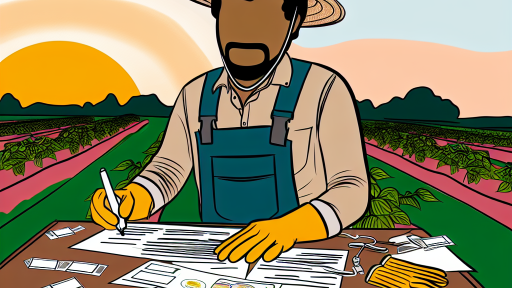Overview of Food Safety Compliance Regulations for Farmers
Importance of Food Safety Compliance
Food safety compliance is crucial for farmers today.
It protects consumers from harmful pathogens and contaminants.
Additionally, compliance helps farmers maintain their market access.
Being compliant builds consumer trust and brand reputation.
Key Regulations Impacting Farmers
Various regulations govern food safety in agriculture.
The Food Safety Modernization Act (FSMA) sets the baseline for compliance.
It emphasizes prevention, requiring growers to adopt best practices.
The Produce Safety Rule is a key component of the FSMA.
This rule outlines standards for growing, harvesting, and packing produce.
Common Compliance Challenges
Farmers often face multiple challenges when ensuring compliance.
Resource limitations can hinder implementation of safety measures.
Additionally, understanding complex regulations is difficult for many.
Seasonal labor shortages can impact training efforts as well.
Adhering to varying state and federal regulations adds confusion.
Strategies for Overcoming Compliance Challenges
Farmers can adopt several strategies to improve compliance.
Transform Your Agribusiness
Unlock your farm's potential with expert advice tailored to your needs. Get actionable steps that drive real results.
Get StartedInvesting in training programs enhances staff knowledge of regulations.
Utilizing technology can simplify documentation and tracking processes.
Collaboration with local agricultural organizations offers resources and support.
Regular audits can identify compliance gaps and areas for improvement.
Benefits of Effective Compliance
Effective food safety compliance yields numerous benefits for farmers.
It reduces the risk of foodborne illnesses in consumers.
Additionally, it protects farmers from potential legal liabilities.
Compliance can also open new market opportunities for growers.
Ultimately, it fosters a safer food system for everyone involved.
Common Challenges in Meeting Food Safety Standards
Understanding Regulatory Requirements
Farmers often struggle to understand complex regulations.
Food safety standards vary significantly across regions.
Additionally, frequent updates to guidelines can cause confusion.
Producers must stay informed about these changes.
Moreover, regulatory agencies may not provide clear assistance.
Resource Limitations
Limited financial resources hinder compliance efforts.
Many farmers lack access to necessary training programs.
Furthermore, small farms often cannot afford certification costs.
This creates disparities in the food supply chain.
Implementation of Safety Practices
Implementing food safety practices requires time and effort.
Farmers may prioritize production over compliance.
This results in unsafe practices going unnoticed.
Additionally, inadequate staff training contributes to issues.
Careful planning is necessary to integrate safety measures.
Managing Traceability and Accountability
Traceability is crucial for identifying safety issues.
Showcase Your Farming Business
Publish your professional farming services profile on our blog for a one-time fee of $200 and reach a dedicated audience of farmers and agribusiness owners.
Publish Your ProfileHowever, farmers struggle to maintain accurate records.
Often, outdated technology complicates data collection.
Moreover, inconsistent labeling leads to accountability challenges.
Farmers must adopt better systems for tracing products.
Dealing with Public Perception
Public confidence in food safety significantly impacts farmers.
Negative media coverage can damage reputations quickly.
Farmers face pressure to demonstrate high safety standards.
Moreover, consumers demand transparency in food production.
Building trust requires effective communication strategies.
Impact of Foodborne Illnesses on Agricultural Practices
Understanding Foodborne Illnesses
Foodborne illnesses significantly affect public health worldwide.
They result from consuming contaminated food or beverages.
Consequently, farmers must prioritize food safety in their operations.
Economic Consequences for Farmers
Foodborne outbreaks can lead to substantial financial losses for farmers.
Recall procedures often incur additional costs and reduce profits.
Moreover, consumer trust can take a long time to restore.
This loss of confidence impacts future sales and marketability.
Regulatory Pressures
Farmers face increasing regulatory scrutiny due to food safety concerns.
Government agencies frequently update guidelines to address these issues.
Compliance with regulations can strain farm resources and operations.
It is essential for farmers to stay informed about changing laws.
Impact on Agricultural Practices
Foodborne illnesses influence farming methods and practices.
Farmers are adopting stricter sanitation protocols in their operations.
They are also investing in technology for monitoring food safety.
Such changes may require training and education for farm workers.
Building Resilience in Agricultural Systems
Addressing food safety challenges strengthens the agricultural sector.
A proactive approach to safety can enhance overall food quality.
Farmers should collaborate with resources available from experts.
This collaboration fosters innovation and sharing of best practices.
Learn More: Understanding Organic Farming Standards
Technological Solutions to Enhance Food Safety on Farms
Data Management Systems
Farmers can utilize data management systems to monitor food safety protocols.
These systems track temperatures and humidity levels during storage.
Additionally, they can log pesticide usage and harvest dates.
Accurate records help maintain compliance with safety regulations.
Farmers can quickly access this information during inspections.
Blockchain Technology
Blockchain technology offers secure and transparent food traceability.
This technology allows farmers to document the entire supply chain.
Moreover, it enhances consumer trust in food safety practices.
Each transaction is recorded, making it easy to trace contamination sources.
As a result, farmers can respond swiftly to food safety issues.
Mobile Applications
Mobile applications provide farmers with on-the-go access to food safety guidelines.
Showcase Your Farming Business
Publish your professional farming services profile on our blog for a one-time fee of $200 and reach a dedicated audience of farmers and agribusiness owners.
Publish Your ProfileThese apps offer checklists for compliance and documentation requirements.
Farmers can also receive alerts about relevant regulatory changes.
This ensures they remain updated on food safety standards.
Furthermore, sharing information with laborers becomes seamless.
Remote Monitoring Systems
Remote monitoring systems enhance the ability to track storage conditions.
Sensors can detect temperature fluctuations and humidity levels.
This technology allows for immediate alerts in case of deviations.
Consequently, farmers can take quick action to prevent food spoilage.
Overall, remote monitoring enhances food safety efforts significantly.
Training and Education Tools
Technology aids in the training of farm employees on food safety practices.
Online courses and webinars provide essential information and updates.
Interactive training modules can engage employees more effectively.
As a result, workers are better prepared to follow safety protocols.
Enhanced education leads to improved overall food safety compliance.
Gain More Insights: Compliance Tips for Farm Labor Laws
The Role of Training and Education in Compliance Improvement
Importance of Training Programs
Training programs are vital for improving food safety compliance among farmers.
They provide essential knowledge about regulations and best practices.
Moreover, these programs help identify potential risks in food production.
Farmers who undergo training are more aware of compliance requirements.
Consequently, they can implement effective measures to mitigate risks.
Types of Training Available
Various training programs cater to the needs of farmers.
Workshops offer hands-on experiences and practical knowledge.
Online courses provide flexibility for busy farmers.
Additionally, seminars invite experts to share insights on compliance updates.
These types of training ensure farmers are well-equipped to handle challenges.
Investing in Education
Investing in education yields long-term benefits for farmers.
Better-educated farmers produce safer food products.
The advantages extend beyond compliance to improve overall farm productivity.
Furthermore, education fosters a culture of safety within the farming community.
Partnerships with Educational Institutions
Collaborating with universities enhances training efforts.
These partnerships can develop customized programs for local farmers.
Involvement of academic experts ensures the latest research informs training.
Such collaborations strengthen community ties and resources.
Continuous Learning and Updates
Food safety regulations are dynamic and frequently updated.
Continuous learning is essential for farmers to stay compliant.
Regular training sessions keep farmers informed about changes.
This ongoing education empowers them to adapt their practices swiftly.
Ultimately, a commitment to continuous learning boosts compliance rates.
Discover More: The Role of Trade Agreements in Farming Success

Case Studies of Successful Food Safety Compliance in Agriculture
Farm Fresh Organics
Farm Fresh Organics implemented strict safety protocols for their produce.
Showcase Your Farming Business
Publish your professional farming services profile on our blog for a one-time fee of $200 and reach a dedicated audience of farmers and agribusiness owners.
Publish Your ProfileThey trained all staff in hygiene and sanitation practices.
As a result, they reduced contamination incidents by over 30%.
The farm regularly conducts audits to ensure compliance is maintained.
These measures have built consumer trust in their brand.
Green Valley Dairy
Green Valley Dairy focuses on implementing technology to enhance food safety.
They use data logging systems to monitor temperature in storage facilities.
This technology helps them maintain optimal conditions for milk preservation.
In addition, they have adopted regular training sessions for all workers.
Consequently, their products meet all regulatory standards consistently.
Sunrise Farms
Sunrise Farms emphasizes traceability in their meat production.
They established a tracking system to monitor every product from farm to table.
This transparency allows for quick responses in the event of a food safety issue.
The farm’s proactive approaches have resulted in fewer recalls.
Moreover, this has strengthened their relationships with distributors.
Riverbend Aquaponics
Riverbend Aquaponics combines aquaculture and hydroponics for sustainable food production.
They ensure their systems maintain high water quality standards.
Regular testing allows them to identify potential hazards quickly.
The farm also educates consumers about their food safety practices.
These efforts enhance customer confidence in their products.
Delve into the Subject: Overview of Agricultural Export Laws
Collaborative Efforts Between Farmers and Regulatory Bodies
Building Strong Partnerships
Farmers and regulatory bodies need to collaborate effectively.
Such partnerships foster trust and mutual understanding.
Furthermore, they facilitate compliance with food safety regulations.
Strong communication channels lead to better information sharing.
Training and Education Initiatives
Training programs are essential for addressing compliance challenges.
Regulatory bodies can offer education on safety standards.
Farmers should engage in workshops to learn best practices.
Continuous learning helps maintain high food safety standards.
Utilizing Technology for Compliance
Technology can streamline reporting and monitoring processes.
Farmers can use software solutions to track compliance metrics.
Additionally, digital platforms enable real-time data sharing.
Such advancements improve transparency and accountability.
Regulatory Flexibility
Regulatory bodies should consider flexible approaches to compliance.
Tailoring regulations to specific farming conditions enhances feasibility.
Moreover, adaptability can lead to better implementation of safety measures.
Feedback Mechanisms
Establishing feedback mechanisms is vital for ongoing collaboration.
Farmers should have avenues to voice concerns and suggestions.
Regulatory agencies should actively seek farmer feedback.
This two-way communication strengthens regulatory practices.
Future Trends in Food Safety Compliance and Farming Innovations
Integration of Technology
Farmers increasingly adopt technology for food safety compliance.
Showcase Your Farming Business
Publish your professional farming services profile on our blog for a one-time fee of $200 and reach a dedicated audience of farmers and agribusiness owners.
Publish Your ProfileTracking systems now utilize blockchain for transparency.
This technology enhances traceability of supply chains.
Additionally, precision agriculture tools help monitor compliance standards.
Farmers utilize drones to survey fields and detect issues early.
Regulatory Changes and Adaptation
The regulatory landscape is evolving rapidly.
Farmers must stay updated on changes to avoid penalties.
Training programs now emphasize compliance education for producers.
Furthermore, farmers are encouraged to utilize compliance management software.
Consumer Demand for Transparency
Today’s consumers demand greater transparency in food sourcing.
This trend drives farmers to promote safe practices more openly.
Labeling initiatives enable consumers to make informed choices.
In response, farmers develop direct-to-consumer sales channels.
Sustainable Practices and Food Safety
Sustainability is now integral to food safety practices.
Farmers implement organic methods to comply with safety standards.
These practices help mitigate chemical contamination risks.
Leaders in the industry advocate for eco-friendly farming solutions.
Smart Irrigation and Water Management
Innovative water management systems increase efficiency in farming.
Smart irrigation helps avoid overuse of pesticides and fertilizers.
This approach minimizes the risk of runoff and contamination.
Furthermore, real-time data analysis supports informed decision-making.
Collaboration and Knowledge Sharing
Collaborative networks promote sharing best practices among farmers.
Community workshops offer valuable insights into compliance strategies.
Partnerships with universities foster research on food safety enhancements.
This collaboration strengthens the agriculture community’s resilience.




